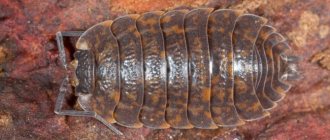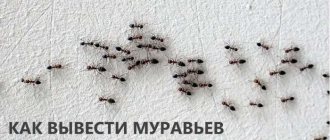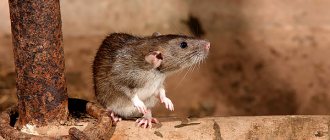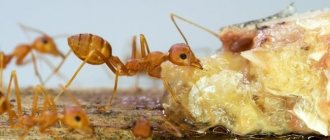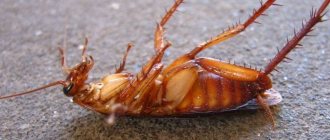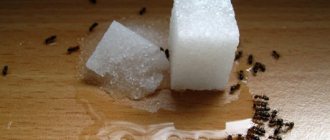There are insects that lead an active lifestyle mainly at night. Some representatives of this group even live in human homes. An example is woodlice in an apartment. Professionals know well how to get rid of these insects, but ordinary people are often far from knowing this issue. Parasites take up residence in the bathroom. When faced with them, you have to think about whether to turn to specialists or get rid of these creatures with home remedies.
Description of appearance
Woodlice is a crustacean creature that lives in damp areas. A terrestrial creature located in a place with high humidity.
- The oblong body of a convex shape is divided into segments. Adults have 7 of them.
- There are two pairs of antennae on the head. The first ones are short, poorly developed, the second mustaches are long. This is the main organ that helps the insect navigate in space and look for a food source.
- The structure of the woodlice is simple. There are 7 pairs of straight legs on the sides, ensuring fast movement. The sixth pair of limbs faces backward, helping the insect to quickly change direction of movement. How many legs a woodlice has depends on its age. Adults have 7 pairs, while larvae have only 6.
The first 5 segments of the body are free, overlapping each other like tiles. Their internal part plays the role of gills - respiratory organs. The upper part protects the body and is a hard shell. Insects breathe with the middle part of the body, the respiratory organs are simplified. The last segment ends with a long tail. In some species, the whiskers and tail look the same; it is difficult to determine where the beginning and end of the body are.
The size of woodlice is no more than 18 mm. Body color may vary depending on the species and age. The color is gray, ash, white, brown. The larvae are always lighter than adults and are born with a white shell. A photo of the woodlice is shown below. You can carefully examine every part of the body.
Interesting!
It is difficult to determine by appearance whether it is an insect or not. Some call the crustacean a harmful bug. Experts, answering the question of what woodlice are, classify them as crustaceans. In everyday life, they are used to calling them insects, without really looking closely at the structure of the body and the features of their vital functions.
woodlouse
What insects are similar to them?
- Silverfish. This wingless small insect belongs to the bristletail family. It is not a representative of crustaceans, unlike woodlice. Its body size is from 0.8 to 1.9 cm. The body has dense silvery scales, and it ends with a pointed tail, which woodlice do not have. Unlike the woodlice, which has seven pairs of legs, the silverfish has only three.
- Kivsyak. Representative of bipedal centipedes. It has a segmented body, with two pairs of legs on each of them. Woodlice have only 14 legs. It has a round body shape, which differs from the oval body shape of the woodlice. They breathe with the help of tracheas, and woodlice use gills for this. They also differ in body size: in woodlice up to a centimeter, in woodlice from 3 to 30 centimeters.
- Glomeris. They are bipedal centipedes. They are often confused with woodlice. However, they are easily distinguished by their glossier color, more legs and the presence of a shield behind the head. Their colors are varied: black, yellow, brown, etc. The body is covered with 12 visible scutes. The number of legs varies from 17 to 21, but woodlice have fewer. They feed on living and dead parts of plants.
Follow simple rules when creating optimal living conditions and indoor microclimate, do not allow high levels of humidity in your house or apartment, and then you will never meet an unwanted guest in the form of woodlice.
If you find an error, please select a piece of text and press Ctrl+Enter.
Taste preferences
What woodlice eat is interesting not only to nature lovers. The question arises for everyone who notices an incomprehensible creature in their bathtub, sink, or toilet. What attracts the insect, how long can it live in the house.
What do woodlice eat in nature - decaying plants, mold. In damp places such food is present in great abundance. Insects live quietly on the street, in basements, without attracting attention to themselves, without causing harm.
With the onset of cold weather, the crustacean makes its way into human housing. The food for woodlice in an apartment is mold, which remains on the walls, water pipes, and pipes when sanitary and hygienic requirements are violated and there is high humidity. And also wet toilet paper, dirt in the corners, on the pipes.
Who are they?
Anyone who has ever seen a woodlice will say that it is an insect. Actually this is not true. These arthropods belong to the family Crustacea and the order Isopods. Over many centuries, this creature has adapted to live on land, but at the same time continues to breathe using gills.
It chooses a place to live that is humid and warm and where it is possible to eat. Most often they choose places near water bodies, in forests, groves and plantings. However, they can be seen in apartments and other residential premises.
Most often in an apartment they can be found in the bathroom because it is here that the humidity is higher than in other rooms. They can also be seen in bags of vegetables or in flower pots.
Wood lice feed on plant foods. Roots, leaves or fruits are suitable for this. They also choose living and dead microorganisms as food. Organic waste, house plants and pantry supplies are also suitable food sources for woodlice.
They are very afraid of bright light, which is why they are nocturnal.
Woodlice do not pose any danger to human life and health. They do not bite and do not spoil food. However, it is worth remembering that on their legs they are capable of carrying viruses and fungi, which is why they are considered spreaders of many diseases. If at least one individual is found, it is necessary to get rid of them immediately.
Life cycle
The life of woodlice
The peculiarities of the life of crustaceans force them to hide during the day and crawl out of shelters at night. You can notice the insect in the evening or during the day in a dark room. Woodlice reproduction in nature begins in April-May. Females mate with males, the seminal fluid enters a special segment on the body. How woodlice reproduce in the future is a rather interesting process.
The seminal fluid is consumed gradually, the female does not need to be fertilized again to reproduce, but mating a second time can occur. Larvae are formed from fertilized eggs in the female's body. They are born as a copy of the female, but differ in size and color.
Folk remedies
- Chlorine (solution of 50 ml per 1 liter of water).
- Boric acid (solution of 2 g per 0.5 liters of water).
- A mixture of dry tobacco, soda and red pepper (the ingredients are mixed in the proportion of 100 g of tobacco: 1 packet of pepper: 2 tablespoons of soda per 1 liter of water).
- Dry kvass (solution of 100 g per 1 liter of boiling water).
- Quicklime (place several containers indoors and leave for 3 days; you must leave the house during this time).
Benefits and harms
Woodlice in nature
In nature, woodlice in large quantities are not called pests. Their significance in nature lies in the processing of rotting, decaying grass. Healthy plants and crops do not attract insects. Woodlice, settling in hotbeds and greenhouses, do not disrupt the growing season of the plant, but save it from fungi and mold. They also loosen the soil, enriching it with oxygen. When assessing the balance between benefit and harm, the beneficial properties of insects prevail.
Why wood lice are dangerous for humans, some experts say - the spread of pathogenic fungi and lichens. In most cases, these creatures are called pests only because they sneak into the apartment and scare the residents with their appearance. Apart from disordering the nervous system, fright, and stress, woodlice do not harm anyone. Insects do not bite and do not spread dangerous diseases.
On a note!
If the apartment is unsanitary, wood lice live not only in the bathroom, toilet, but also crawl into the kitchen. In this case, their presence in the house is even more unpleasant. Insects crawl on tables, food, dishes, and the sink. In this case, the risk of infection increases, but the person himself is more to blame for this.
How to identify a pest
Woodlice and silverfish are equally unpleasant to look at and equally not parasites of humans. They can be pests, nothing more.
This type of symbiosis between humans and small arthropods is called commensalism, its essence is that a person receives neither harm nor benefit from them, but the “settlers” will always find food next to a person.
Woodlice are small crustaceans, and silverfish are from the class of insects.
Woodlice have an oval and convex body 10-15 mm long; its shell and long mustache are clearly visible.
Their usual habitat is wildlife; in an apartment they have to live in the toilet and bathroom - where there is the most moisture. They mostly feed on plants and decaying organic matter.
Silverfish have an elongated, elongated body. As well as long antennae and several curved tails at the back of the body. Color silver, black, greenish, colorless.
Individuals can grow in size from a few millimeters to 1.3 cm. They feed on organic debris and love cellulose (they can be found on books and near paper wallpaper). They readily eat any fabric and can damage clothing.
Read here How to get rid of small midges - how to get rid of them once and for all at home (85 photos)
Both of them make you want to get rid of them, no matter how harmless they may seem. And the methods of fighting against both species will be similar.
Varieties of woodlice
Types of woodlice
In our area, the common woodlice predominates. Her body structure and appearance were described above. In nature, there are many species of crustaceans, which also frighten people with their appearance.
- Rough woodlice. Externally it differs in color - brown color predominates. Rough shell, hence the name. The body is flexible. When in danger, he prefers to run away and does not curl up into a ball. It settles in greenhouses, warehouses, basements, and appears in apartments during the cold season.
- Giant woodlice. There is no representative of this species of woodlice in our area. The sea creature is never shown on land. The size of the crustacean reaches 7.5 cm. The giant creature is capable of seriously scaring a person in the water. Despite its terrifying appearance, the crustacean is safe and does not even bite.
- Cymothoa exigua or tongue woodlice. A symbiotic parasite that lives in the mouth of the pink snapper and replaces its tongue. The length of the parasite is 4 cm. It is not able to cause harm to humans;
- Cylisticus convexus. Lives all over the world. The carapace is smooth, dark in color. Prefers rural areas. Lives in compost pits, barns, cowsheds. It poses no danger to animals or people and rarely appears in apartments.
Types of domestic crustaceans
Reference! There are more than 3,500 species of woodlice on the planet, most of which live in water, and only about 250 species of crustaceans have been able to evolve and adapt to life on land, however, for normal life they need a large amount of moisture.
Therefore, only the most unpretentious species take root in residential premises , since this is far from the best habitat for them. Let's look at what types of woodlice can most often be found in apartments.
Preventive measures
To prevent the appearance of insects in the bathroom and toilet, you must:
- Repair taps, pipelines.
- Get rid of moisture, dampness.
- To clean up.
- Wipe pipes, pipelines, floors in hard-to-reach places.
- Get rid of wet rags, napkins, washcloths.
- Wash the floor every week with the addition of a chlorinated product.
- Place a grille on the ventilation hole, seal the cracks in the wall and floor.
Insecticides are used to control insects only if other measures do not give the desired result.
Fighting methods
Any means are good in pest control. But in certain situations, efforts may be in vain. Let’s say, trying to destroy makrush at the dacha yourself, you can only aggravate the situation. Even if most of the individuals fall into the trap or “taste” the insecticide, a considerable number of them will remain in the corners. They will continue to actively spread, annoying the owner of the territory. To solve this problem, a comprehensive approach is required. For a guaranteed result, it is better to contact experienced disinfectors. They know well which products will work effectively and will allow you to remove pests from your home forever.
People have many ways to deal with woodlice in an apartment. These white, or less often dark brown, insect pests easily die if poison is used against them. But they also multiply at a considerable speed. This is why standard methods of combating them may not be effective. Faced with the lack of results, the owner of a private home has no choice but to turn to professionals . They are able to determine exactly where the pests are coming from.
Chemicals
The market today offers an impressive list of products aimed at exterminating woodlice and other household creatures. The most popular today are:
- "Dichlorvos";
- "Mole";
- "Tetrix".
The gel from the German manufacturer Schabengel has also proven itself well. This is a special bait designed for crustaceans. It is used to poison pests that appear in secluded places in the home.
The use of these substances may be unsafe, so you must strictly follow the instructions included with each drug. Special precautions are required when small children and animals live in the house. After treatment, be sure to ventilate the room and wash all surfaces.
Folk recipes
Such methods are no less effective. Parasites are effectively eliminated without any safety concerns. There are several techniques that have proven positive:
- Liquid kvass with boiling water. Take 100 g of the first component and add to 500 ml of water. Stir and spray in the bathroom and other areas where woodlice have infested. The next day you can wash the surfaces.
- Boric acid. Prepared in the same way as the previous product.
- Chlorine. Take 40 g of bleach per liter of water, after which the walls and floors are washed with the resulting solution.
- A mixture of tobacco, soda and pepper. These components are diluted in a liter of water, after which the pest areas are watered. Leave for a while, then wash with water and chlorine.
- Salt. To kill parasites, just sprinkle it into cracks and corners.
- Birch broom. Place a few pieces in the corners and leave overnight. They attract insects in an amazing way. In the morning all that remains is to throw away the trap.
- Potato. They make a hole in the tuber, and then place it in places where parasites accumulate. During the night, a large number of individuals climb inside. During the day, the tubers are thrown away.
- Lime. One of the most effective components for controlling woodlice in an apartment. Place a little quicklime bleach in a bucket and extinguish it with water. Carefully lay out the pieces in areas where woodlice live. After this, close the door tightly and leave the room for several days. It is not recommended to enter it during this time.
All of the above methods adversely affect the area where insects live, so they are likely to leave the occupied area. At the same time, it is not enough to get rid of parasites once. The cause of their appearance must be identified and eliminated, otherwise a re-invasion cannot be avoided.
The role of woodlice in nature and human activity
It’s worth noting right away that the beneficial effects of woodlice far outweigh any damage they can do. However, these creatures have a bad undeserved reputation as pests, mainly because they wander around the apartment mainly at night, usually in order to avoid overwatering in the presence of high humidity, or vice versa - in search of water to replenish her body's reserves.
Woodlice can spread over considerable distances during these nocturnal wanderings. Therefore, representatives from the damp basement of the house can be found in the bedroom of an apartment on the seventh floor.
In the garden, woodlice rarely attack living plants, preferring to eat vegetation that has begun to decompose. However, in greenhouses they can sometimes chew seedlings, but this rarely causes any significant economic damage. In the forest floor of deciduous forests, as well as on compost heaps, woodlice play a vital role. They chew dead plants into small fragments and deposit them as fecal pellets, which quickly decompose. In addition, woodlice can also feed on fungal spores on plant leaves, which prevents the development of many plant diseases.
The deposition of fecal granules containing fungal spores in the deep moist layer of fallen leaves may be important in stimulating putrefactive decomposition in forest humus layers and the formation of fertile soil mass. Thus, the activity of woodlice accelerates the process of decomposition of organic matter and helps return essential nutrients to the soil.
What is the most effective way to get rid of woodlice?
Comprehensive measures are the key to successful pest control.
How to get rid of small midges - how to get rid of them once and for all at home (85 photos)- How to get rid of fruit flies - where do they come from and tips on how to quickly and easily get rid of fruit flies at home (105 photos)
Flies in the apartment: effective methods and recommendations on how to get rid of flies (110 photos and videos)
All methods are appropriate - from the use of strong toxic substances to the creation of unsuitable living conditions.
Advice:
- follow the rules prescribed in the instructions for each drug, as well as safety precautions;
- do not reduce or increase the dosage of drugs;
- do not combine many insecticides at once (dilute them over time, if necessary).
Despite the fact that drugs are considered safe for humans, this does not mean that they are useful; they are still chemicals with a pronounced toxic effect.
Behavior
The development of woodlice is not sufficient for them to be accused of consciously seeking favorable conditions, so their movements are determined by reflexes. In an attempt to find a place where the body will lose a minimum of moisture, the woodlice can change the speed of movement and turning.
You can conduct an experiment: put the woodlice in a dry or even hot place and observe it. She will move faster, spin more actively, looking for a way to escape from the negative environment. When placed in a dark, damp and cool place, the insect moves slowly, sometimes freezing for a long time.
What harm can woodlice cause?
A small number of these crustaceans are not capable of causing serious harm to humans. But, if a large colony of woodlice has settled nearby, the following problems may arise:
- soil compaction and disruption of air circulation in the root system of plants;
- harming young seedlings;
- infection of plants by various infections and fungi;
- spoilage and contamination of food supplies;
- damage to walls and ceilings in the house.
Despite the possible harm, wood lice can also bring benefits. In the process of their life activity, they enrich the soil with useful substances and make it more fertile.
Peculiarities of reproduction and distribution of woodlice
Woodlice can be considered very unique organisms in terms of sexuality, since they can produce offspring in two ways. We are talking about direct copulation and the method of parthenogenesis .
Their mating usually occurs in the spring. In this case, the seed falls into a pair of special holes located on the female’s body, or rather in the fifth segment of her body. These holes communicate with seed receptacles, which subsequently spontaneously collapse and then the seed enters a chamber called the oviduct. When the first phase of “pregnancy” ends, the woodlice begins to molt and radically changes its body shape. Thus, it adapts for subsequent bearing and birth of offspring. The previously mentioned paired genital openings of the woodlice are transformed into a single one. It is through it that already fertilized eggs are released. The brood chamber is formed by small plates that form on the front legs. It is inside that her eggs “live” for a month and a half until they mature. After which the female will be released into the world to live independently. The partially unused seed remains inside the woodlice and is, as it were, temporarily preserved to serve as a means for fertilizing the next generation.
Separately, it is worth noting that male woodlice are very patient and persistent, since the sexual intercourse itself is very long. They look for a partner in advance, take the position necessary for copulation and wait for a long time until she throws off her old shell and opens the seminal receptacles.

